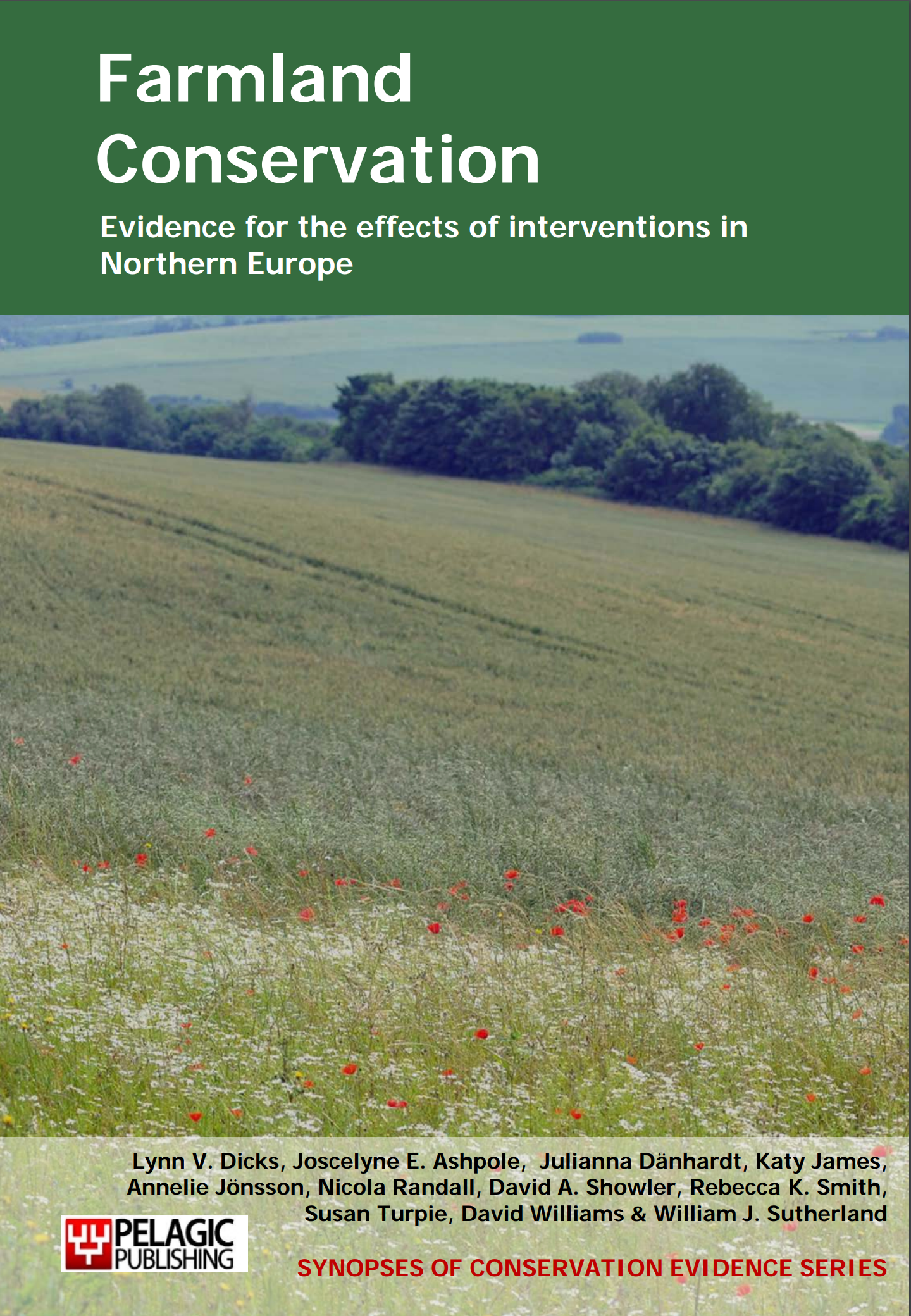Actions to conserve biodiversity
We have summarised evidence from the scientific literature about the effects of actions to conserve wildlife and ecosystems.
Review the evidence from the studies
Not sure what Actions are? Read a brief description.
Search for evidence
e.g. "frogs chytrid"
119 Actions found
Refine
Hide
119 Actions found
Download Actions
| 0 selected |
|
Order results by:
| Action | Effectiveness | Studies | Category | |
|---|---|---|---|---|
|
Remove flood defence banks to allow inundation Action Link |
Unknown effectiveness (limited evidence) | 2 |
|
|
|
Control weeds without damaging other plants in conservation areas Action Link |
Unknown effectiveness (limited evidence) | 12 |
|
|
|
Plant more than one crop per field (intercropping) Action Link |
Evidence not assessed | 5 |
|
|
|
Reduce tillage Action Link |
Likely to be beneficial | 46 |
|
|
|
Control scrub Action Link |
Unknown effectiveness (limited evidence) | 1 |
|
|
|
Take field corners out of management Action Link |
Evidence not assessed | 1 |
|
|
|
Add yellow rattle seed Rhinanthus minor to hay meadows Action Link |
Unknown effectiveness (limited evidence) | 2 |
|
|
|
Implement 'mosaic management', a Dutch agri-environment option Action Link |
Evidence not assessed | 2 |
|
|
|
Delay mowing or first grazing date on pasture or grassland Action Link |
Likely to be beneficial | 15 |
|
|
|
Leave uncut strips of rye grass on silage fields Action Link |
Likely to be beneficial | 6 |
|
|
|
Restore/create species-rich, semi-natural grassland Action Link |
Beneficial | 71 |
|
|
|
Use organic rather than mineral fertilizers Action Link |
Beneficial | 19 |
|
|
|
Manage ditches to benefit wildlife Action Link |
Likely to be beneficial | 11 |
|
|
|
Undersow spring cereals, with clover for example Action Link |
Likely to be beneficial | 18 |
|
|
|
Plant crops in spring rather than autumn Action Link |
Unknown effectiveness (limited evidence) | 9 |
|
|
|
Raise mowing height on grasslands to benefit farmland wildlife Action Link |
Unknown effectiveness (limited evidence) | 7 |
|
|
|
Reduce fertilizer, pesticide or herbicide use generally Action Link |
Beneficial | 47 |
|
|
|
Manage woodland edges to benefit widlife Action Link |
No evidence found (no assessment) | 0 |
|
|
|
Support or maintain low intensity agricultural systems Action Link |
No evidence found (no assessment) | 0 |
|
|
|
Increase the proportion of semi-natural habitat in the farmed landscape Action Link |
Unknown effectiveness (limited evidence) | 5 |
|
|
|
Make direct payments per clutch for farmland birds Action Link |
Unknown effectiveness (limited evidence) | 3 |
|
|
|
Provide refuges during harvest or mowing Action Link |
Unknown effectiveness (limited evidence) | 3 |
|
|
|
Mark bird nests during harvest or mowing Action Link |
Unknown effectiveness (limited evidence) | 1 |
|
|
|
Plant cereals for whole crop silage Action Link |
Unknown effectiveness (limited evidence) | 3 |
|
|
|
Exclude livestock from semi-natural habitat (including woodland) Action Link |
Unknown effectiveness (limited evidence) | 8 |
|
Download Actions
| 0 selected |
|

Farmland Conservation - Published 2013
Farmland Synopsis
Watch this search
If you are familiar with RSS feeds, please click the button below to retrieve the feed URL:
RSS feed for this searchIf you are unfamiliar with RSS feeds, we would suggest reading this BBC article.
Unfortunately, due to the number of feeds we have available, we cannot provide e-mail updates. However, you could use tools such as Feed My Inbox to do this for you.
What are 'Individual studies' and 'Actions'?
Individual studies
An individual study is a summary of a specific scientific study, usually taken from a scientific journal, but also from other resources such as reports. It tells you the background context, the action(s) taken and their consequences.
If you want more detail please look at the original reference.
Actions
Each action page focuses on a particular action you could take to benefit wildlife or ecosystems.
It contains brief (150-200 word) descriptions of relevant studies (context, action(s) taken and their consequences) and one or more key messages.
Key messages show the extent and main conclusions of the available evidence. Using links within key messages, you can look at the paragraphs describing each study to get more detail. Each paragraph allows you to assess the quality of the evidence and how relevant it is to your situation.
Where we found no evidence, we have been unable to assess whether or not an intervention is effective or has any harmful impacts.





)_2023.JPG)














